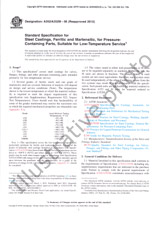We need your consent to use the individual data so that you can see information about your interests, among other things. Click "OK" to give your consent.
ASTM D3967-16
Standard Test Method for Splitting Tensile Strength of Intact Rock Core Specimens
Translate name
STANDARD published on 1.11.2016
The information about the standard:
Designation standards: ASTM D3967-16
Note: WITHDRAWN
Publication date standards: 1.11.2016
SKU: NS-667144
The number of pages: 5
Approximate weight : 15 g (0.03 lbs)
Country: American technical standard
Category: Technical standards ASTM
The category - similar standards:
Earthworks. Excavations. Foundation construction. Underground works
Annotation of standard text ASTM D3967-16 :
Keywords:
compression testing, indirect tensile strength, loading tests, rock, splitting tensile strength, tension (tensile) properties/tests,, ICS Number Code 93.020 (Earth works. Excavations. Foundation construction. Underground works)
Additional information
| Significance and Use | ||||||||||||||
|
5.1 By definition the tensile strength is obtained by the direct tensile test. However, the direct tensile test is difficult and expensive for routine application. The splitting tensile test appears to offer a desirable alternative, because it is much simpler and inexpensive. Furthermore, engineers involved in rock mechanics design usually deal with complicated stress fields, including various combinations of compressive and tensile stress fields. Under such conditions, the tensile strength should be obtained with the presence of compressive stresses to be representative of the field conditions. 5.2 The splitting tensile strength test is one of the simplest tests in which such stress fields occur. Also, by testing across different diametrical directions, possible variations in tensile strength for anisotropic rocks can be determined. Since it is widely used in practice, a uniform test method is needed for data to be comparable. A uniform test is also needed to make sure that the disk specimens break diametrically due to tensile stresses perpendicular to the loading diameter. Note 2: The quality of the results produced by this standard
is dependent on the competence of the personnel performing it, and
the suitability of the equipment and facilities used. Agencies that
meet the criteria of Practice D3740 are generally considered capable of
competent and objective testing/sampling/inspection/etc. Users of
this standard are cautioned that compliance with Practice
D3740 does not in itself
assure reliable results. Reliable results depend on many factors;
Practice D3740 provides a
means of evaluating some of those factors.
|
||||||||||||||
| 1. Scope | ||||||||||||||
|
1.1 This test method covers testing apparatus, specimen preparation, and testing procedures for determining the splitting tensile strength of rock by diametral line compression of disk shape specimens. Note 1: The tensile strength of rock determined by tests other
than the straight pull test is designated as the “indirect” tensile
strength and, specifically, the value obtained in Section
9 of this test is termed the
“splitting” tensile strength.
1.2 Units—The values stated in SI units are to be regarded as standard. The values given in parentheses are mathematical conversions to inch-pound units, which are provided for information only and are not considered standard. Reporting of test results in units other than SI shall not be regarded as nonconformance with this test method. 1.3 All observed and calculated values shall conform to the guidelines for significant digits and rounding established in Practice D6026. 1.3.1 The procedures used to specify how data are collected/recorded or calculated, in this standard are regarded as the industry standard. In addition, they are representative of the significant digits that generally should be retained. The procedures used do not consider material variation, purpose for obtaining the data, special purpose studies, or any considerations for the user's objectives; and it is common practice to increase or reduce significant digits of reported data to be commensurate with these considerations. It is beyond the scope of this standard to consider significant digits used in analysis methods for engineering design 1.4 This standard does not purport to address all of the safety concerns, if any, associated with its use. It is the responsibility of the user of this standard to establish appropriate safety and health practices and determine the applicability of regulatory limitations prior to use. |
||||||||||||||
| 2. Referenced Documents | ||||||||||||||
|
We recommend:
Technical standards updating
Do you want to make sure you use only the valid technical standards?
We can offer you a solution which will provide you a monthly overview concerning the updating of standards which you use.
Would you like to know more? Look at this page.




 Cookies
Cookies
